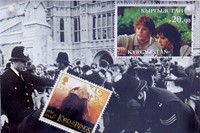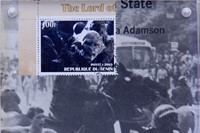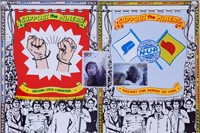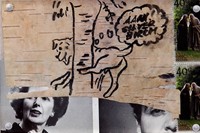Milly Burroughs reconnects with an old school friend, the artist Benjamin Edwin Slinger, whose current solo exhibition rethinks representations of working-class culture presented to us in mainstream art, photography and film
“I’m incredibly unhappy when I don’t make things … I’m not going to say it’s a compulsion – I don’t want to give that hacky kind of answer – but it is like that,” says Sheffield-born, London-based artist Benjamin Edwin Slinger, who I’ve known since we were both secondary school students in a dull, grey, former mining town in the suburbs of Leeds. Back then they were known mononymously as Slinger and I don’t think either of us ever imagined that we’d one day be having a conversation about their current solo exhibition A Medieval Choreography at Galerie Karin Guenther, in Hamburg, Germany. Now we are 30, and it’s not just the years we spent as teenagers we have to reflect on, but a decade of processing our own experiences, and the way others perceive our northerness and working-class heritage in lives that have become so far removed from our Yorkshire roots.
Slinger’s lived experience of being an artist is typical of those from the northern working class, where money is most definitely an object – the type that gets in the way of progression when it runs out – and geography is not on your side. While their tales of soul-destroying shifts in popular Soho restaurants, and being forced to inhabit rooms best described as airing cupboards, are unsurprising to those familiar with the fetishised trope of the starving artist, it remains a rarely relatable experience within the realities of the art world, where most professional creatives are still supported by a safety net of familial financial stability.
On show at Galerie Karin Guenther until 25 June, A Medieval Choreography sees Slinger combine deeply emotive imagery from the UK miners’ strikes of the 1980s with collectible paraphernalia from popular culture in a number of mixed media works. While the fusion of these two strands of visual culture may appear crass at a glance, the artist explains that there is a more meaningful relationship in these works than in the majority of botched representations of working-class culture presented to us in mainstream art, photography and film.
“I’m a little bit tired of images of the working class and how it has been attached to trash and insignificance. It’s like, ‘oh, look at this painting of a Mars bar’ – isn’t it saying it’s working class because working class poor people eat shit? Isn’t that hilarious?” They continue, “I want to separate it from the idea of cultural working class to actually significant events within the history of labour – and I don’t mean the political party. I chose images of the miners’ strikes, beyond my own family connection, because there’s so much significance [in them] and they’re not really treated in the same way as other images of significance. I’d much rather adopt these images than the ‘nice’ things that have been attached to working-class people, because there’s nothing really working class about, you know, junk food. The multi-billion pound companies they come from are not supportive of, nor representative of, anything that I consider to be working class and I don’t want to trivialise myself or working-class people to the point where it’s like crisps and lager and fucking darts. I’m mixing these images in with collectibles from the Lord of the Rings universe, and I don’t want that to be read as me poking fun – it’s not a one-liner, it’s not a joke. Not to me.”
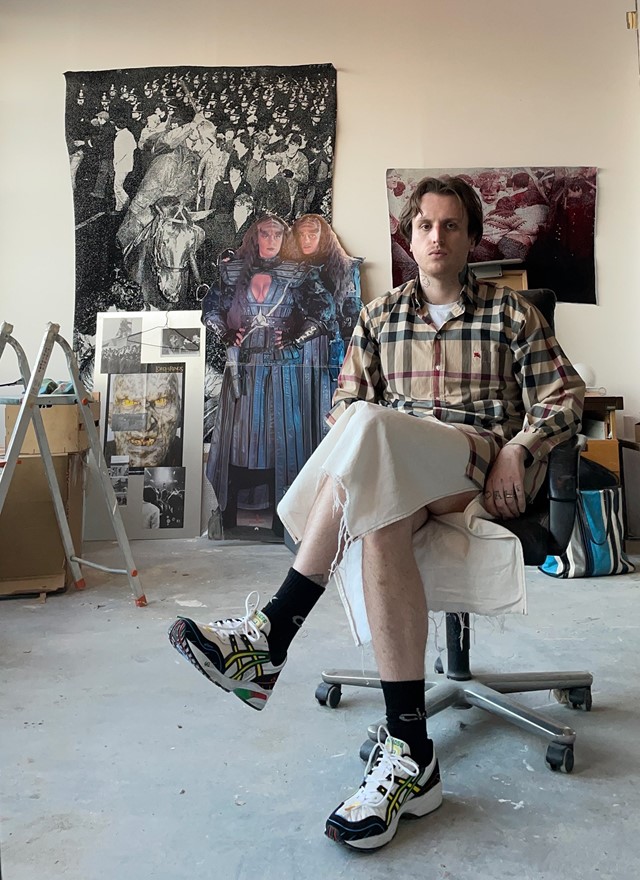
Talking about the role of memorabilia in their work, they suggest that their own neglected wants and childhood desires have bled into their artistic psyche. “For a while, I didn’t quite understand the relationship between what I wanted to buy for myself and what I wanted to buy for my art practice. It’s still blurred. A very blurred boundary where I’ll buy something to make something out of it and then I like it so much that I can’t do anything [with it]. But all of that is usually collectibles, like collector’s items or things with a quantifiable value – beyond the value of the object itself. I collect stamps. I collect Lord of the Rings collectibles. I collect Pokemon things that are specific to the era of Pokemon, not Pokemon cards – the detritus surrounding Pokemon? They all hold a very specific value that I think is definitely related to not having things in my life, whether as a child or a teenager. It’s wanting to hoard these valuable trinkets.”
Attachment and detachment are themes that dominate our conversation – one conducted over Zoom, in a time when my visiting the UK hasn’t been possible for almost a year and a half due to living in Germany and Slinger is unable to attend their show in Germany due to being confined to the UK. When I ask why they chose now to bring this body of work to life, it’s a sense of confused trauma and nostalgia that rises to the surface. They explain, “In relation to attaching myself to this kind of northern working-class conversation, I really did feel spurred on by the pandemic, and by Brexit and detachment, because I don’t have any family living there anymore – just my brother. My parents got divorced, my mum moved down south and my little brother moved down south. There’s only one of us left up north and I don’t really go. I haven’t been in a long time and I don’t really know whether I want to. It’s not necessarily a homesick feeling. It’s not about needing to be in God’s own country or whatever. It’s that classic feeling that you feel separated from your roots, whatever that means. I’ve a lot of space from it, and time to reflect – and obviously the catalyst of having had Brexit has been looming constantly – and it makes me want to throw up.”


